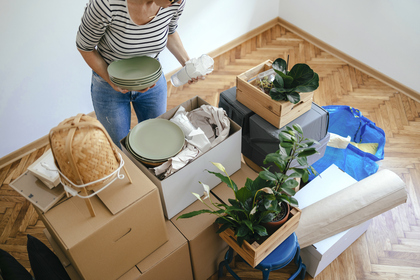How to Pack Fragile Items for Moving Day
Moving this summer? You’ve probably got a lot on your plate—and if you’re like most people, you might be wondering how to safely pack your most delicate items. Properly packing fragile items is one of the most important steps in ensuring a successful move, whether you’re working with local Niagara movers or planning a cross-country relocation with long-distance movers. From kitchen glassware and electronics to your favourite family keepsakes, fragile items can be tricky to pack—but with the right guidance, you can do it with confidence. In this guide, we’ll walk you through everything you need to know about packing fragile items safely and securely, so your belongings arrive at your new home just the way you remember them.
Why it Matters: The Cost of Poor Packing
When something fragile breaks during a move, the cost isn’t just financial—it’s emotional. A broken mug can be replaced, but your grandmother’s teacup or a wedding keepsake often cannot. The heartbreak of discovering broken belongings can take the shine off what should be an exciting day. That’s why proper packing isn’t just a bonus—it’s essential. Commonly damaged items during moves include dishes, glassware, mirrors, TVs, lamps, and artwork. These pieces are especially vulnerable when handled quickly or packed with little protection. Taking time to wrap and box them the right way offers peace of mind—and prevents frustration on moving day.
Gathering the Right Materials
Before you begin, gather your packing supplies. The quality of the materials you use makes a big difference. Strong, double-walled boxes are better than reused grocery store ones, and plain, ink-free packing paper is gentler on delicate surfaces than old newspapers. In addition to sturdy boxes and paper, you’ll need bubble wrap, foam sheets, stretch wrap, packing tape, and a permanent marker for labelling. If you’re packing stemware or dishes, cardboard dividers or dish packs can help keep items separated and secure. And while “Fragile” stickers aren’t magic, they do help signal moving companies to take extra care.
The Right Box for the Job
Using the right size and type of box makes all the difference. The rule of thumb? Heavy items go in smaller boxes, and lighter, bulkier items go in larger boxes. Also consider:
-Dish packs with built-in dividers for glassware
-Mirror boxes for framed artwork and mirrors
-Electronic boxes (original packaging is ideal, but custom-fit options are available)
If you’re unsure which box is right, the team at Bird’s Moving is always happy to provide guidance based on the items you’re moving.
Wrapping Techniques: Item by Item
When it comes to wrapping, patience is key. Each item should be wrapped individually. For dishes and glassware, begin by placing the item on a sheet of packing paper, then roll it carefully, tucking in the sides as you go. For items like wine glasses or mugs, fill the inside with crumpled paper before wrapping the outside. Once wrapped in paper, adding a second layer of bubble wrap creates a protective cushion, especially for items travelling a long distance. Plates and bowls should be packed vertically in boxes—like records rather than stacked flat. This helps distribute weight more evenly and reduces pressure points that could cause breakage.
For electronics like televisions, game consoles, or laptops, remove batteries and cables before packing. If you have the original boxes with fitted foam inserts, use them. If not, wrap the item securely in anti-static bubble wrap and cushion it with soft materials like foam or tightly packed paper. Place wrapped components like remotes and cords in labelled plastic bags to keep everything organized. When wrapping framed photos or mirrors, protect the corners first, then place a piece of cardboard or foam over the glass surface. Wrap the entire item in bubble wrap, securing it with tape. For larger items, using a custom-fit mirror box offers the best protection.
Delicate collectibles and home décor require extra attention as well. Wrap each piece in packing paper, then bubble wrap, and make sure they're packed in boxes that leave no room for movement. For fragile odd-shaped items, towels, linens, or foam inserts can be helpful filler materials. For information on handling larger appliances, check out our guide on preparing household appliances for your move.
Packing Boxes Strategically
Once wrapped, it’s time to place your fragile items in boxes:
1. Cushion the bottom with crumpled packing paper or foam peanuts.
2. Place heavier items first, then layer lighter ones on top.
3. Fill all gaps with paper, foam, or even towels to prevent shifting.
4. Leave a buffer of soft padding at the top before sealing.
Seal the box tightly with strong packing tape–use the H-taping method (across the seam and along the edges) for maximum hold. When you’re done, give the box a gentle shake. If you feel movement, open it back up and add more filler.
Labelling: A Small Step with Big Impact
Labelling may feel like an afterthought, but it can make a huge difference in how your boxes are handled. Clearly mark boxes with the word “Fragile” on multiple sides. Add directional arrows if the box must remain upright, and write down what’s inside and where it belongs in your new home. Think of it this way, the clearer your labelling, the better your move will go.
What About During the Move?
Proper packing is just one part of the equation when it comes to how to pack fragile items for moving day. It’s equally important to ensure your boxes are handled with care. Fragile items should be loaded last and placed on top of heavier, sturdier boxes. Never stack heavy boxes on top of those marked “Fragile”. If you’re moved with Niagara movers like Bird’s Moving, our team is trained to recognize and properly stack these boxes safely. Grouping your fragile items together can also help movers identify which boxes need extra care. Clear communication with moving companies–especially about boxes containing valuables or sentimental items–helps guarantee they receive the highest level of attention throughout the move.
Going the Distance: Extra Precautions for Long Distance Moves
If you're moving long-distance, extra protection may be needed. Long trips mean more handling, more jostling, and more risk. Consider double-boxing, especially delicate or valuable items. This means wrapping and placing the item in one small box, cushioning it, then placing that box inside a larger one with additional padding. Additionally, creating an inventory of your fragile items and taking photos can be helpful for peace of mind. If you’ve opted for moving insurance, documentation will also be necessary for filing claims in the rare event of damage. And remember, even if your move takes you hundreds of kilometres from Niagara, Bird’s Moving’s experience as long distance movers ensures we can get you–and your belongings–there efficiently and safely. With the right team and the right preparation, distance doesn’t have to mean difficulty.
Professional Help Makes a Difference
While it’s possible to pack everything yourself, there’s no shame in asking for help—especially when it comes to irreplaceable items. Professional packing and moving services like those offered by Bird’s Moving & Storage ensure your items are wrapped and boxed using industry-standard techniques and quality materials. Our trained packers know how to handle everything from crystal stemware to vintage electronics and have the supplies and experience to do it right. If you’re pressed for time or just want peace of mind, let us take the stress off your hands.
Real Tips from the Pros at Bird’s Moving
After helping families and businesses move for more than 85 years, we’ve learned a lot about how to pack fragile items for moving. One of the biggest tips? Take your time. It’s better to go slow and do it right than to rush and risk damage. Use soft household items–like towels or scarves–as filler for odd-shaped breakables and when in doubt, overprotect. We also suggest packing your most valuable or sentimental fragile items last, so they stay with you or near the front of the truck. Some people even prefer to transport these items in their personal vehicle for added peace of mind. For more expert guidance, be sure to check out our post on 6 packing tips that make your move stress-free.
Common Questions: Fragile Packing FAQs
Is bubble wrap or packing paper better?
Both are useful, and often, the best protection involves using both. Paper helps create a snug wrap around the item, while bubble wrap adds a cushion that absorbs shock.
Can I use towels or clothing to pack fragile items?
Absolutely. Soft textiles can work well as padding, especially between larger items or as top and bottom layers in a box. Just don’t rely on them for breakables like glass or ceramics.
How far in advance should I pack fragile items?
Pack your fragile items a day or two before your move. This minimizes the chances of the boxes being moved around or stacked poorly before moving day.
Your Pre-Move Packing Game Plan
Packing fragile items isn’t something to leave until the last minute. Start early and give yourself plenty of time and space. Pack room by room, wrapping each item with care and label boxes clearly. Double-check each box before sealing it, and don’t skimp on filler–when in doubt, cushion more. If you ever feel overwhelmed, remember that Bird’s Moving’s full range of moving services is just a phone call away to help make your move easier and less stressful.
Ready to Move? Trust One of the Finest Moving Companies in the Region!
At Bird’s Moving & Storage, we specialize in careful, efficient moves—whether it’s across town, throughout Ontario, or across the country. Our professional moving services are designed to meet your needs at every stage of the process. From expert advice to full-service packing solutions, we’re here to help every step of the way. Reach out today to start planning a move that’s stress-free, secure, and tailored to you.





